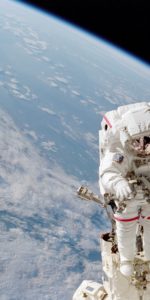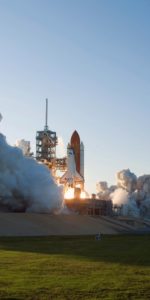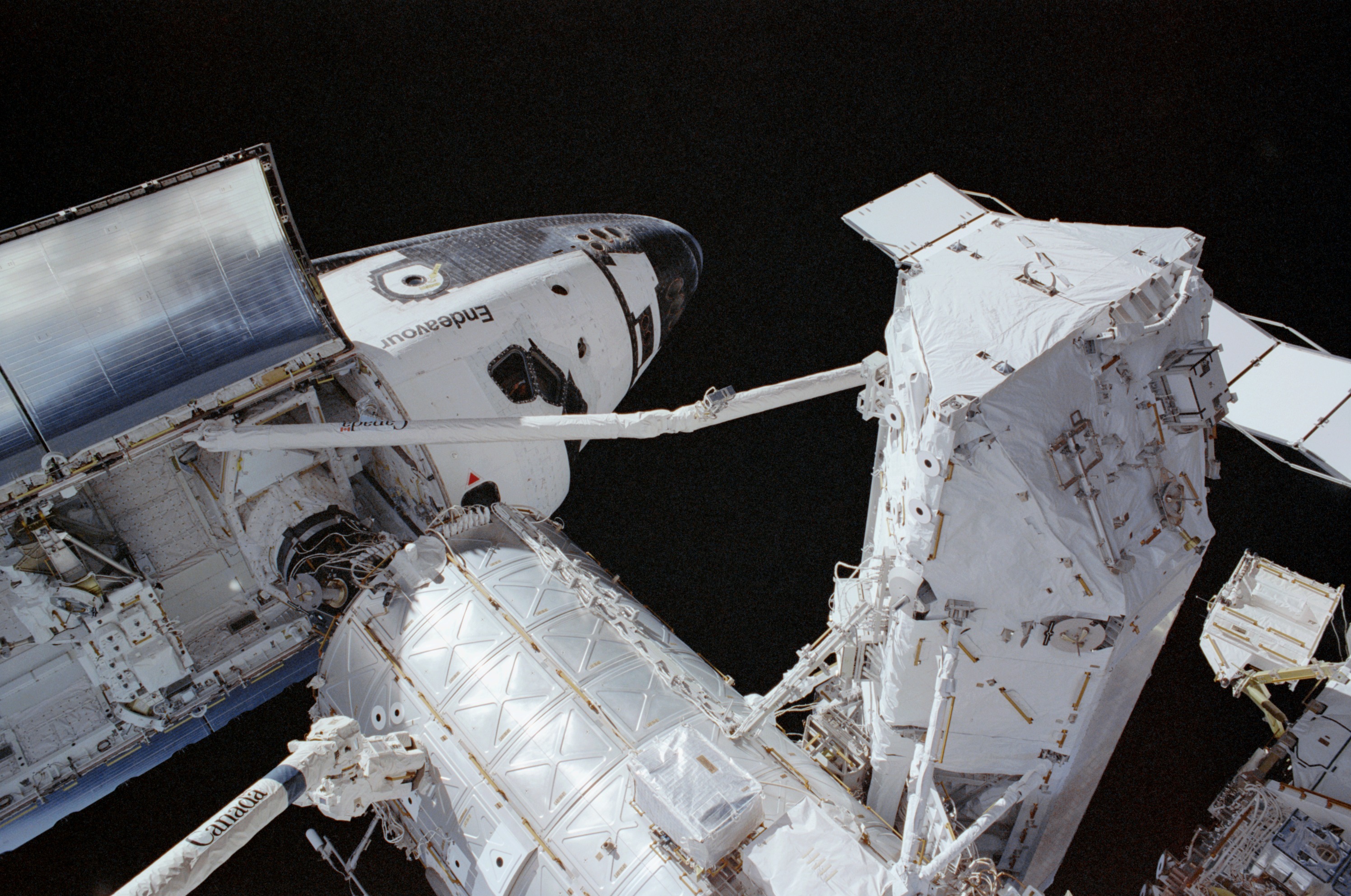
Over the past five decades, more than 500 people have voyaged beyond Earth’s atmosphere and into space. Some have been “frequent flyers”, chalking up multiple missions into low-Earth orbit and—in the case of 24 Apollo astronauts—to lunar distance. Yet with the advent of the Space Shuttle program, the idea of frequently flying humans into space literally grew wings. Fifteen years ago, next week, Franklin Chang-Diaz became only the second person after fellow U.S. astronaut Jerry Ross to chalk up a seventh launch from Earth.
By their own admission, neither Chang-Diaz nor Ross wanted their records to stand for long and both were philosophical about why they did it. “I don’t see it so much as a mark in history,” said Ross, “as just another opportunity for me to go do something I thoroughly enjoy.” Chang-Diaz, for his part, hoped that future astronauts would go on to fly 10-15 missions as part of their careers. “It doesn’t do much to me in terms of keeping records,” said the Costa Rica-born veteran. “I’m hoping that these kinds of record will be easily broken and many times over.” Sadly, a decade and a half after Ross’ and Chang-Diaz’s missions, their joint record remains unbroken. And it seems unlikely to be broken anytime soon.
Two days after launching aboard shuttle Endeavour on the afternoon of 5 June 2002, the seven-strong STS-111 crew—Commander Ken Cockrell, Pilot Paul Lockhart, Mission Specialists Chang-Diaz and Philippe Perrin and Expedition 5 increment members Valeri Korzun, Sergei Treschev and Peggy Whitson—arrived at their destination: the International Space Station (ISS). With pinpoint precision and grace, Cockrell maneuvered Endeavour to a smooth 12:25 p.m. EDT docking with Pressurized Mating Adapter (PMA)-2, on the forward end of the station’s U.S. Destiny lab.
A couple of hours later, at 3:08 p.m., the hatches swung open and the seven new arrivals flooded into Destiny, to be engulfed in handshakes and bear hugs from the station’s incumbent Expedition 4 crew of Yuri Onufrienko, Carl Walz and Dan Bursch. Following a safety briefing, the ten-strong crew set to work moving equipment and supplies into the ISS, as well as the space suits for Chang-Diaz and Perrin’s EVAs. Additionally, the custom-molded seats of Korzun, Treschev and Whitson were manhandled through the station and into the Soyuz TM-34 spacecraft, which they would use in the event of an emergency return to Earth. With the completion of this transfer, at 6:55 p.m. EDT, the Expedition 4 team formally became members of STS-111 and Korzun’s crew officially kicked off Expedition 5.
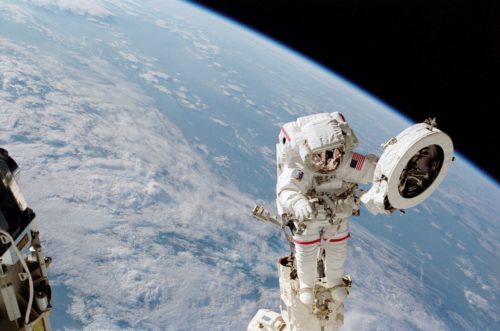
Notwithstanding the failure of one of three redundant controllers on the Flash Evaporator System (FES), Endeavour was performing admirably on her 18th mission into space. Early on 8 June, Cockrell took the controls of the shuttle’s Canadian-built Remote Manipulator System (RMS) mechanical arm and removed the 21-foot-long (6.4-meter) Leonardo Multi-Purpose Logistics Module (MPLM) from the payload bay, successfully berthing it onto the Earth-facing (or “nadir”) side of the Unity node at 10:28 a.m. EDT.
Six hours later, the hatches between the node and the cylindrical Leonardo were opened, beginning a period five days to transfer over 5,600 pounds (2,540 kg) of equipment and supplies into the station. In addition to the eight Resupply Return Stowage Racks (RSRs), five Resupply Stowage Platforms (RSPs) and two International Standard Payload Racks (ISPRs), the MPLM also carried a group of lithium hydroxide canisters for carbon dioxide removal. Elsewhere, in Endeavour’s middeck, were a number of powered payloads, including a gaseous nitrogen freezer, commercial units for bioprocessing and protein crystal growth, a scientific refrigerator-incubator and a biomass production system.
In spite of STS-111 being his record-tying seventh mission—and after deploying and retrieving satellites, performing science and rendezvous and even launching a spacecraft to Jupiter—one thing that Chang-Diaz had never done was an EVA. Nor had “rookie” astronaut Perrin, who became only the third Frenchman to make a spacewalk. By the time Endeavour landed, not only had Chang-Diaz entered the ranks of the EVA fraternity, but Perrin had established a record for the greatest number of spacewalking hours ever attained by a French citizen. It is a record he continues to hold to this day.
With Chang-Diaz designated “EV1”, with red stripes on the legs of his EMU, and Perrin as “EV2”, in a pure white suit, the spacewalkers departed the station’s Quest airlock at 11:27 a.m. EDT on 9 June. With only a four-person “core” crew of STS-111, it was left to Lockhart to serve as the “intravehicular” astronaut, talking the spacewalkers through their tasks, whilst Cockrell handled RMS operations. “They are not super-complicated,” Chang-Diaz said of the EVAs, “but they’re not quite that simple, either. They’re sort of middle-of-the-road spacewalks, which will be just right for Pepe and I to execute.”
Their first task was to install a Power and Data Grapple Fixture (PDGF) onto the P-6 truss segment, in order to allow the 35,000-pound (15,875 kg) piece of hardware—which included batteries, radiators and a pair of gigantic Solar Array Wings (SAWs)—to be relocated from its temporary place to its permanent place, later in the ISS assembly sequence. With Chang-Diaz riding the end of Canadarm2, and Perrin “free-floating”, the duo then stowed six Micrometeoroid Orbital Debris (MMOD) shields onto the exterior of PMA-1, at the junction between the station’s U.S. Orbital Segment (USOS) and Russian Orbital Segment (ROS). The shields were installed on the station’s Zvezda service module during an August 2002 EVA by Korzun and Whitson.
Earlier in STS-111’s docked phase, one of the four Control Moment Gyroscopes (CMGs) experienced a mechanical failure, manifested in the form of a “growling” sensation, according to Carl Walz. Following their MMOD shields task, Chang-Diaz performed a photographic and visual inspection of the CMG, which was determined to have suffered a mechanical failure in its spin bearing. A minimum of two functional CMGs were required to maintain ISS operations and a replacement gyroscope was slated to ride uphill on STS-114 in March 2003. However, the loss of Columbia and the 2.5-year grounding of the shuttle fleet meant that the failed CMG was not replaced until August 2005.
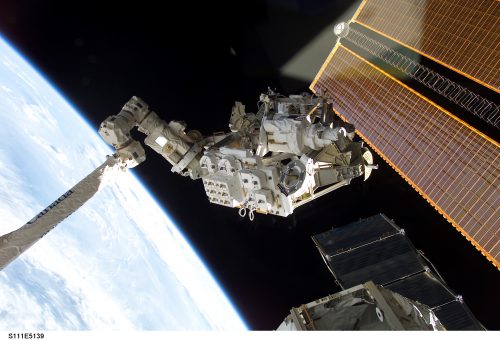
Closing out their first EVA, Chang-Diaz and Perrin removed thermal blankets from the MBS, allowing Cockrell to command the latches to release the base system from its carrier in the shuttle’s payload bay at 6:21 p.m. EDT. At the controls of Canadarm2, Walz and Whitson grappled the MBS and maneuvered into a “pre-install” position, a couple of feet from its eventual destination on the MT. It was left in this pre-install position overnight, for thermal conditioning, ahead of integration with the MT. In the meantime, the spacewalkers returned inside Quest at 6:41 p.m., after seven hours and 14 minutes.
Next morning, Walz and Whitson grappled the 3,300-pound (1,500 kg) MBS and mated it with the MT. Capture latches on the MBS were commanded to close around a bar on the mobile transporter, setting all the pieces in place for EVA-2 by Chang-Diaz and Perrin. At 11:20 a.m. EDT on 11 June, the spacewalkers departed Quest and set to work. Their first task was to connect primary and backup video and data cables, as well as primary power cables, between the MT and MBS. That done, Mission Control uplinked commands for the mobile transporter to remotely connect its umbilical attachments.
Chang-Diaz and Perrin deployed an auxiliary grapple fixture, known as the Payload Orbital Replacement Unit Accommodation (POA), then secured four bolts between the MBS and the MT. This effectively completed the configuration and put Canadarm2 in pole position to “walk” off its perch on the Destiny lab and become a movable robot, driving up and down the expansive truss. Closing out EVA-2, the spacewalkers relocated a television camera, added extension cables and wire ties and photographed their work. They returned inside the space station after exactly five hours.
Elsewhere, progress to complete other aspects of the STS-111 mission was brisk. Seventy-three percent of MPLM cargo transfers had been completed by this stage and a formal “change-of-command” ceremony was held, in which Korzun formally took the helm of the ISS from Onufrienko. Later that night, Walz and Bursch established a new U.S. space endurance record of 188 consecutive days in orbit, exceeding the achievement of fellow astronaut Shannon Lucid. By the time Endeavour landed on 19 June, Walz—with a career total of 230 days across his four space missions—became the most experienced U.S. astronaut, a record he would hold until December 2003.
Chang-Diaz and Perrin’s third and final spacewalk took place on 13 June and, in the eyes of the entire crew, was particularly critical. Three months earlier, Canadarm2 experienced an electrical glitch in one of its two redundant power and data channels. It was later determined than a short in the arm’s wrist roll joint had created inadvertent commanding in the primary commanding channel and unexpectedly activated the brakes. Although the backup commanding channel was not adversely affected, Canadarm2 would play a major role in several downstream shuttle missions to install new truss segments. It was imperative that the troubled wrist roll joint was promptly replaced. The closeness of the failure and the assignment of the repair job to STS-111 gave the astronauts only around six weeks to prepare for the task.
The spacewalkers departed Quest at 11:16 a.m. EDT and set to work. First, they removed the 500-pound (225 kg) Latching End Effector (LEE)—Canadarm2’s “hand”—and temporarily stowed on a handrail on the Destiny lab. Their next step was to release six Expandable Diameter Fastener (EDF) bolts holding the failed wrist roll joint to the adjoining yaw joint and an additional bolt connecting power, data and video umbilicals. Perrin removed the failed joint and stowed it in the shuttle’s payload bay and the pair worked together to install its replacement, tightening six new EDFG bolts to secure it to Canadarm2.
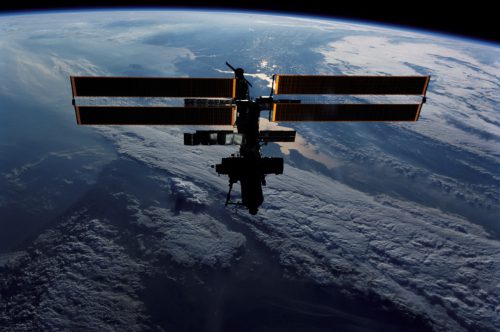
“We knew the clock was ticking,” Perrin reflected and it was essential that the arm be brought back to powered status as soon as possible. At length, the astronauts re-attached the LEE and electrical power was re-applied to the system. From inside the ISS, Korzun checked out the arm and it was triumphantly confirmed to be back to fully operational status at 4:43 p.m. Wrapping up their EVA after seven hours and 17 minutes, Chang-Diaz and Perrin had totaled 19.5 hours outside the space station.
STS-111 was now heading into its homestretch, with Perrin overseeing the detachment of the Leonardo MPLM and its replacement into Endeavour’s payload bay late on the afternoon of 14 June. A day later, the two crews bade each other farewell and Endeavour undocked from the space station at 10:32 a.m. EDT, as they flew serenely over western Kazakhstan. As was customary on station missions, the pilot—Lockhart—assumed manual control for the undocking and fly-around inspection of the ISS. At length, at 12:15 p.m., Lockhart executed a departure “burn” to increase Endeavour’s separation distance.
In anticipation of returning to Earth on the 17th, Cockrell, Lockhart and Chang-Diaz tested the shuttle’s thrusters, aerosurfaces and Hydraulic Power Units (HPUs), but little could they have realized that they would remain in orbit for longer than expected. Rain and thunder showers at the Shuttle Landing Facility (SLF) runway at the Kennedy Space Center (KSC) in Florida caused the first day’s attempt to be called off. Endeavour’s crew had no greater luck on 18 June either and were again thwarted by the poor Florida weather. This raised the likelihood that they would be directed instead to the backup landing at Edwards Air Force Base, Calif.
And that was precisely how circumstances evolved. Three opportunities existed to land at Edwards on 19 June and, aiming for the first opportunity, the shuttle’s Orbital Maneuvering System (OMS) engines were fired at 12:50 p.m. EDT. With the Expedition 4 in recumbent seats on the middeck, joined by Perrin as their “mother hen” in an upright seat, only three astronauts—Cockrell, Lockhart and flight engineer Chang-Diaz—were on the flight deck for re-entry. Despite his training, parts of the re-entry surprised Lockhart. “Endeavour came alive at around Mach 5,” he remembered. “All of a sudden, you could hear the wind and she started shaking and I realized that things were happening really quick.”
Touching down on Edwards’ concrete Runway 22 under perfect blue Californian skies at 10:58 a.m. PDT (1:58 p.m. EDT), STS-111 was over after almost 14 days in space and 5.8 million miles (9.3 million km) traveled. Lockhart deployed the drag chute and Cockrell realized that the onset of gravity was not to be trifled with. A cheer came from the four men on Endeavour’s middeck…quickly followed by a request for their commander to apply the brakes. “Okay, Taco,” they called, using Cockrell’s nickname, “you’re past mid-field, you’re below 140 knots, you can use the brakes now!”
Feeling particularly “heavy” after 14 days of weightlessness, Cockrell told them that if he could manage to lift his lead-like feet to reach the pedals, he would do so…
This is part of a series of history articles, which will appear each weekend, barring any major news stories. Next week’s article will focus on the 10th anniversary of STS-117, which brought additional power (and a measure of symmetry) to the International Space Station (ISS) in June 2007.
Be sure to “LIKE” AmericaSpace on Facebook and follow us on Instagram & Twitter!




